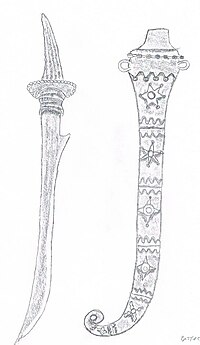Piso Halasan
| Piso Halasan | |
|---|---|
 An illustration of a Piso Halasan | |
| Type | Sword |
| Place of origin | North Sumatra (North Tapanuli Regency), Indonesia |
| Service history | |
| Used by | Batak people |
| Specifications | |
| Length | 65–100 cm |
| Blade type | Single edge |
| Hilt type | Deer horn, antelope horn, ivory |
| Scabbard/sheath | Wood |
A Piso Halasan (also known as an Eccat, Ekkat, Engkat, or Piso Eccat) is a traditional sword of the Batak people from North Tapanuli Regency, North Sumatra, Indonesia.
Description
A Piso Halasan is typically a sword with a hilt made of deer horn or antelope horn, although horn-shaped hilts of cast metal are also found. The blade is made of a mixture of several kinds of metal and is used as a deadly weapon in battles.[1] It has a straight back and a narrow point. Its broadest part is near the point, and there is a notch near the hilt. The scabbard is broader at the top and usually terminates at the bottom in a narrow curved point, partly or totally covered with metal.[2] The sword may be adorned with engravings and forged with metals that include poisons.[3]
Cultural
Batak land (North Sumatra) consisted of many kingdoms which were governed by raja (kings or leaders). Piso Halasan was a symbol of power for the kings and leader in Batak land. Piso Halasan can be translated as The Sword of Happiness, the sword was created to enable the master of the sword to bring happiness to the people they rule. Piso Halasan was a very dangerous weapon and often used in battle. Poison was often applied to the edge of the blade when it was used for battle.[4] Only rich rajas and other dignitaries possessed a Piso Halasan with an ivory hilt, known as a Piso Gading.[3]
References
- ^ Jamaludin S. Hasibuan (1982). Primitive Art of the Ancient Batak in Sumatra, Volume 1. Yayasan K.J. Mahoni. ASIN B0006ECEMW.
- ^ Albert G Van Zonneveld (2002). Traditional Weapons of the Indonesian Archipelago. Koninklyk Instituut Voor Taal Land. ISBN 90-5450-004-2.
- ^ a b Jamaludin S. Hasibuan (1986). Batak Art And Culture. J. Hasibuan. ASIN B0000CQNRS.
- ^ Bisuk Siahaan (2005). Batak Toba: Kehidupan Di Balik Tembok Bambu. Kempala Foundation. ISBN 979-99530-0-6.
Further reading
- George Cameron Stone; Donald J. LaRocca (1999). A Glossary of The Construction, Decoration and Use of Arms and Armor: In All Countries and In All Times. Courier Dover Publications. ISBN 978-0-486-40726-5.
- Hasibuan, Jamaludin S.; William M. Gaugler (1982). Primitive Art of the Ancient Batak in Sumatra: Volume 1. Yayasan K.J. Mahoni. ASIN B0006ECEMW.
- Evangelista, Nick; William M. Gaugler (1995). The Encyclopedia of The Sword. Greenwood Publishing Group. ISBN 978-0-313-27896-9.



